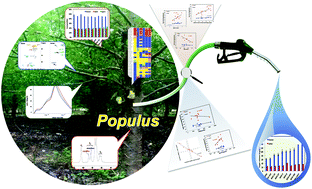Insights of biomass recalcitrance in natural Populus trichocarpa variants for biomass conversion†
Abstract
Populus has been investigated as a promising biomass feedstock for alternative fuels and chemicals. Physicochemical characteristics and genomic information of biomass feedstocks are among the essential information that can help not only advance our understanding of biomass recalcitrance but also in its efficient utilization. Herein, the recalcitrance of natural Populus variants was elucidated in three aspects: (1) sugar release, (2) physicochemical properties, and (3) relative variation of gene expression within natural poplar variants. The sugar release performance of natural Populus variants was evaluated with their correlation with biomass recalcitrance-related characteristics. Among the physicochemical properties of poplar, the lignin content, lignin molecular weight, lignin S/G ratio, and cellulose accessibility were found to correlate with sugar release. The results demonstrated that the lignin content was negatively correlated with sugar release, whereas the lignin molecular weight, lignin S/G ratio, and cellulose accessibility were positively associated with poplar sugar release. The trend of differential gene expression of each variant also supports the characterization results and their effects on biomass conversion.



 Please wait while we load your content...
Please wait while we load your content...